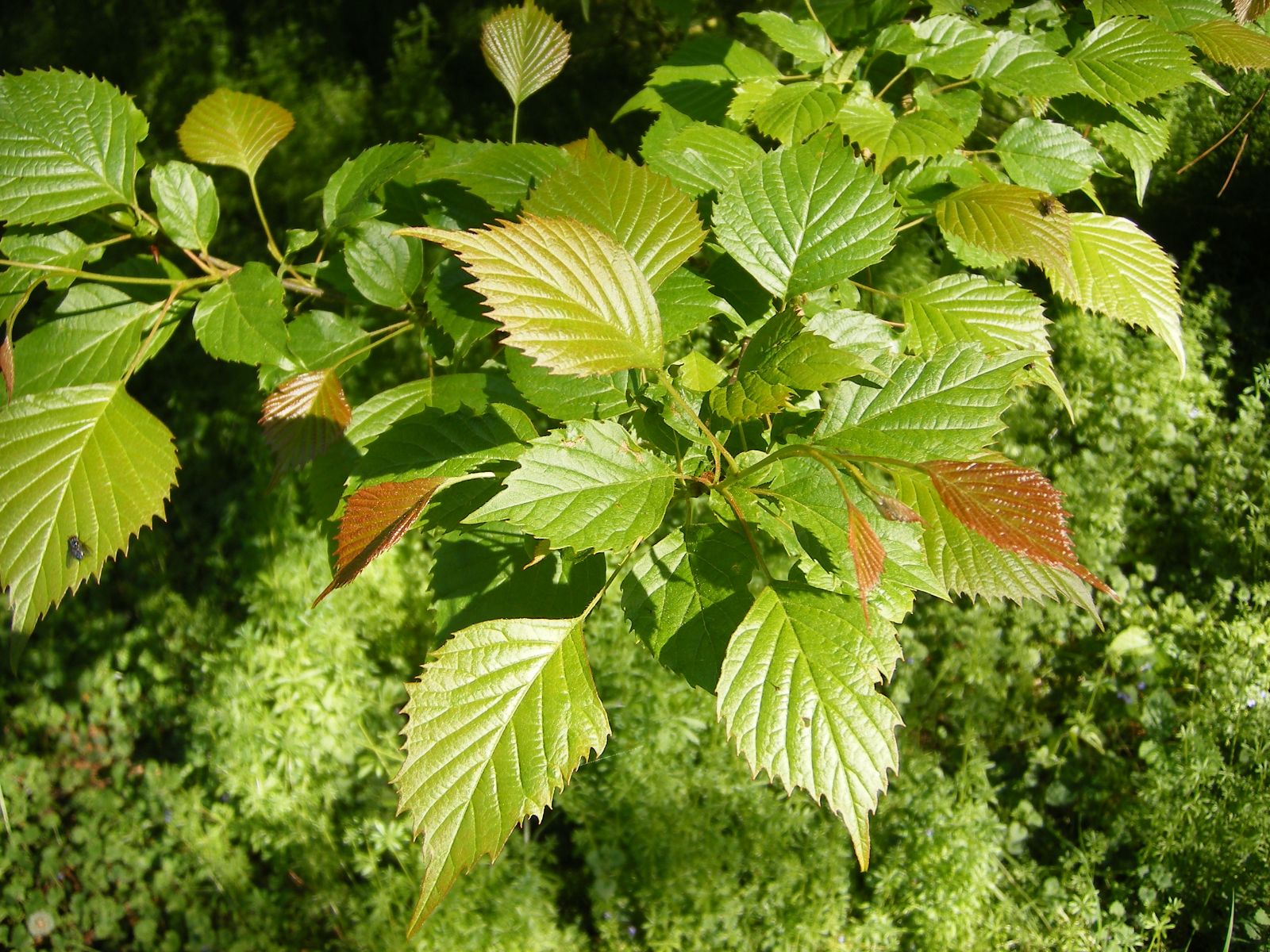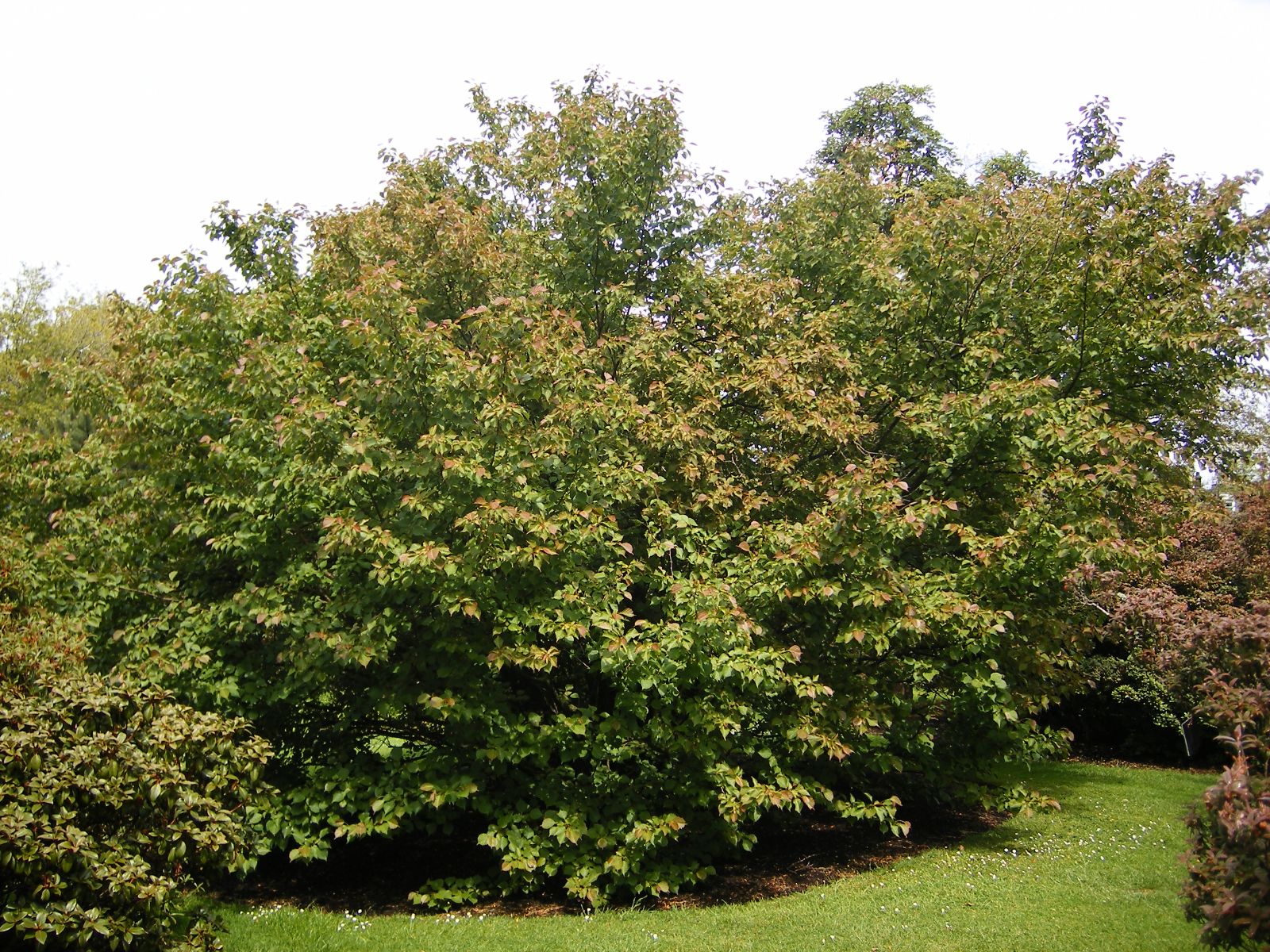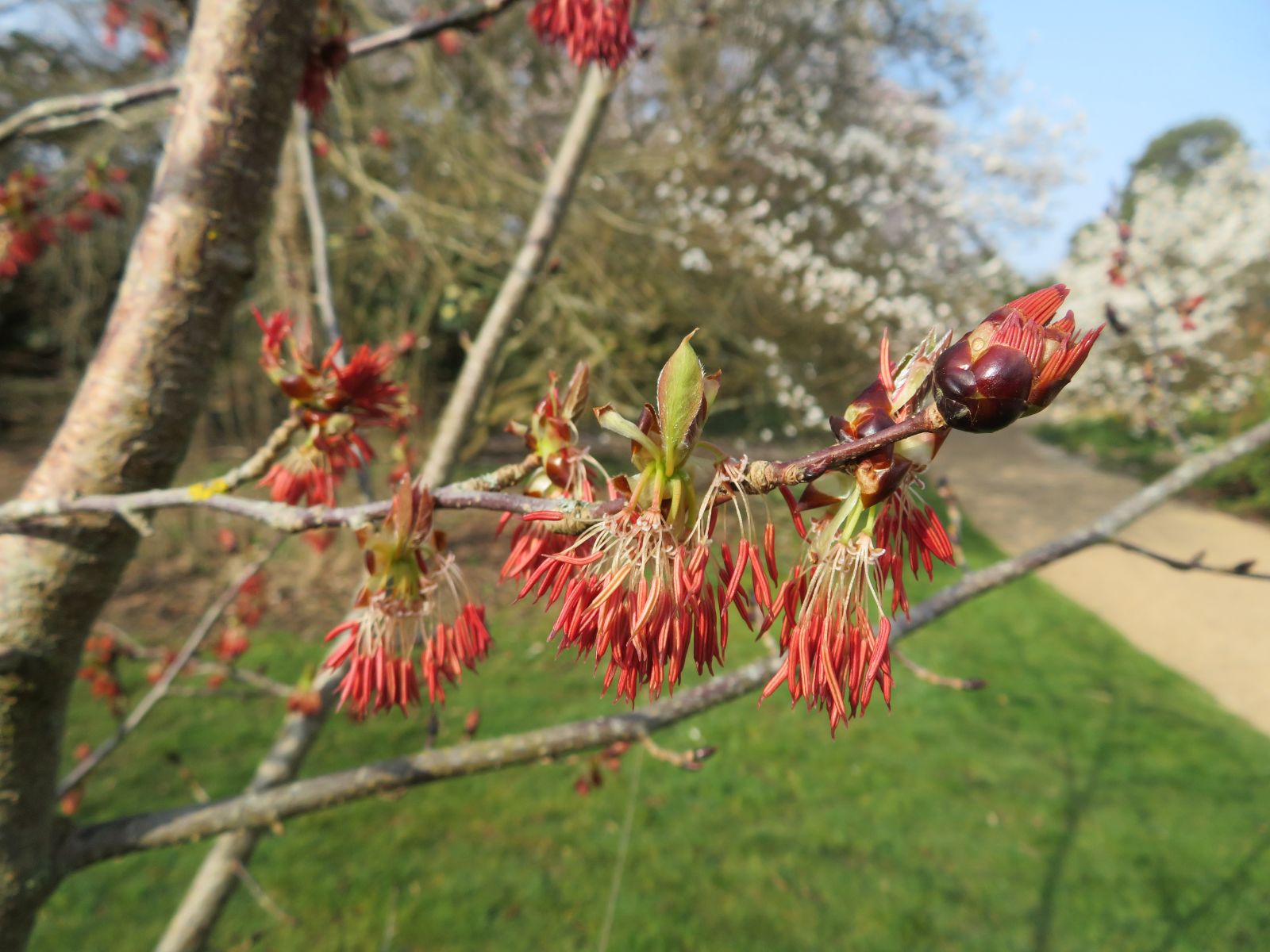Euptelea
Sponsor
Kindly sponsored by
Peter Hoffmann
Credits
Owen Johnson (2023)
Recommended citation
Johnson, O. (2023), 'Euptelea' from the website Trees and Shrubs Online (treesandshrubsonline.
Family
- Eupteleaceae
Common Names
- Tassel Tree
Two species of deciduous small tree or many-stemmed tall shrub. Bark dark brownish grey, rather smooth but with bands of lenticels and some fissures in age. Twigs purplish to grey, glabrous; buds alternate, hidden in summer at the base of the leaf-stalk, with many shiny dark red-brown to black scales. Leaf ovate or suborbicular, with somewhat irregular toothing and a rather abruptly acuminate tip; petiole often long; spring flush reddish. Flowers in spring before the leaves, in axils of leafy shoots; perfect, lacking sepals or petals, appearing as clusters of 6–19 drooping stamens with bright red, much elongated anthers; stigmas sessile. Fruit in summer, in clusters of 6–31 on slender stalks, each a narrowly obovate samara 5–12 mm long, with a brown wing all around and with 1–4 small (1.5–2.5 mm wide) blackish seeds in the centre. (Fu & Endress 2001; Bean 1981; Smith 1946; Jacobson 1996).
The two species of Euptelea – E. polyandra Siebold & Zucc. from the mountains of Japan and E. pleiosperma Hook. f. and Thomson, which is scattered across mainland east Asia – have long been recognised as ‘living fossils’: the survivors of a group found widely in the palaeontological record across the Old World, and only distantly related to other living plants (Cao et al. 2016; Jensen & Kadereit 2012). The genus was described (from E. polyandra) in 1840, and it became conventional to place it within the family Trochodendraceae, along with a rag-bag of other plants too ‘primitive’ for their position within the tree of evolution to remain at all obvious; the first botanist to propose that Euptelea is distinct enough to merit its own family was Philippe Van Tieghem in 1900. (Van Tieghem used a French rather than a Latinate form for his family name – Euptéléacées – which is why the authorship of the family Eupteleaceae is conventionally attributed to Karl Wilhelm, ten years later (Smith 1946).) Recent genetic studies have confirmed the isolated status of the Eupteleaceae and have suggested that the family remains close to ancestral root of the order Ranunculales (Jensen & Kadereit 2012).
Their very distinctiveness probably presents a good enough reason to grow a Euptelea. But these are also quietly attractive little trees. Their dangling clusters of crimson stamens all along the twigs in early spring can be compared to the floral display of Parrotia; the Japanese name for E. polyandra is Fusazakura, meaning ‘cherry with (flowers in) tufts’. The inconspicuous stigmas only become receptive after the stamens in their cluster have fallen (preventing self-fertilisation). The winged seeds which develop through summer are interesting rather than colourful and have given the genus its name: this Greek derivation can be roughly translated as ‘with a complete wing’ and does not imply any relationship to the New World genus Ptelea (the hop-trees); the similarity of the winged fruit of Euptelea to those of the hop-trees (and to Ulmus, the elms) is an example of convergent evolution, although the outline of the wing in Euptelea is distinctively obovate, rather than rounded, and tapers into the stalk. But it is as foliage trees that Euptelea are most likely to be grown: the rather circular leaves are carried gracefully and flush red in spring before maturing to a peculiarly brilliant moss-green, and the red tends to linger around the margin to emphasise each serration. In E. polyandra, these teeth and the leaf-tip are drawn out into a sunburst of extravagantly jagged points, making this the plant to choose as a single foliage feature. Both species can show bright, reddish or yellow autumn colours.
Like most plants of very ancient ancestry, Euptelea are remarkably free of pests and diseases (Stewart 2010), having presumably outlived whatever insects and fungi evolved to exploit them. In the wild, both species grow in moist, sheltered woods in areas with ample rainfall through the growing season, so that in cultivation they are vulnerable to summer drought and in warmer areas they prefer at least dappled shade. In fact they appear even more temperamental in this respect than Cercidiphyllum japonicum (Cao et al. 2016), a much more widely cultivated tree which is often observed to suffer in dry summers when planted in full sun, and they are unlikely to adapt to the combined heat and humidity of the American Deep South (Jacobson 1996). Euptelea have a tendency to grow slightly untidy sprouts and suckers from the base, which can be pruned out to create a small specimen tree. Transplants can be somewhat tricky to establish (Stewart 2010) but are adapted to a wide range of acid or alkaline soils (Edwards & Marshall 2019).
The natural ranges of the two Euptelea do not overlap, raising the possibility that they will hybridise when grown together in collections. (Such a hybrid is likely to be more vigorous than either parent, but its cultivation would blur the subtly distinctive natures of the parent species and there seems no good reason to set about breeding a cross, nor to sell it as such.) However, these two trees – still so similar in appearance – may have been isolated from one another for so many million years (Cao et al. 2016) that genetic drift could have imposed some obstacles to hybridisation. The species’ similarity makes it seem likely that the few nurseries which do offer these plants could occasionally supply one in error for the other: a specimen planted by the late Maurice Mason in one of his great gardens in Norfolk (UK), and illustrated above, was labelled as E. pleiosperma in 2009, but tends in foliage features to E. polyandra. A similar tree in Meise Botanic Garden (19800993) was one of two supplied by the Esveld nursery in 1980 as E. pleiosperma, and was considered by Dirk De Meyere as a possible hybrid (D. De Meyere pers. comm.; Meise Botanic Garden 2023). Genetic analysis would probably be needed to confirm this plant’s ancestry; to be a cross, its seed would also have needed to be collected from a garden already growing both species – and although Meise itself does uncontroversial specimen of both (from accessions in 1972 and 1983), most other western collections tend to contain just one or the other, possibly in the mistaken belief that they are so similar as to be interchangeable. There is also a likelihood that Esveld was propagating its plant by layering, rather than from seed (D. De Meyere pers. comm.) In terms of foliage, the Meise tree seems closer to E. polyandra, and like that species it carries just one seed per samara (Kenneth Bauters pers. comm.: Kenneth was kind enough to check a hundred seeds in January 2023).
Key to Euptelea | ||
| 1a | Leaf with an abruptly acuminate 'drip-tip' 10–40 mm long and with very irregular marginal teeth to 15 mm deep, sometimes with odd, tiny, secondary teeth; leaf-base sometimes rounded to truncate; 1 seed per samara (rarely 2): | E. polyandra |
| 1b | Leaf with a less pronounced 'drip-tip; 8–20(–30) mm long, and with less irregular marginal teeth to 4 mm deep; leaf-base more or less tapering (cuneate); (1–)2(–4) seeds per samara: | E. pleiosperma |



